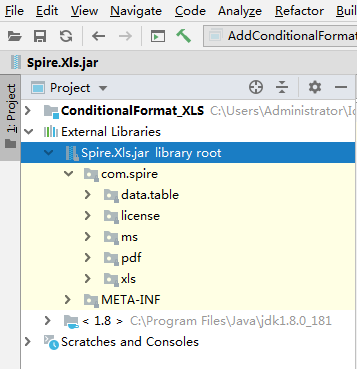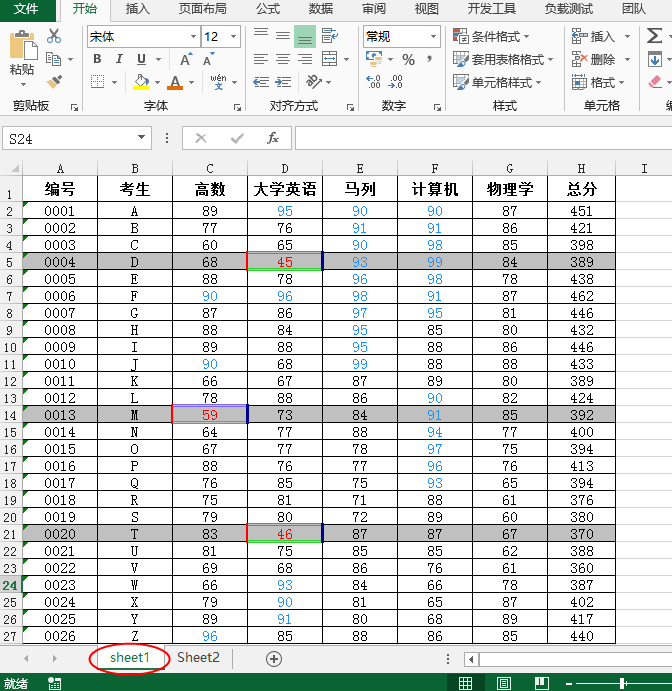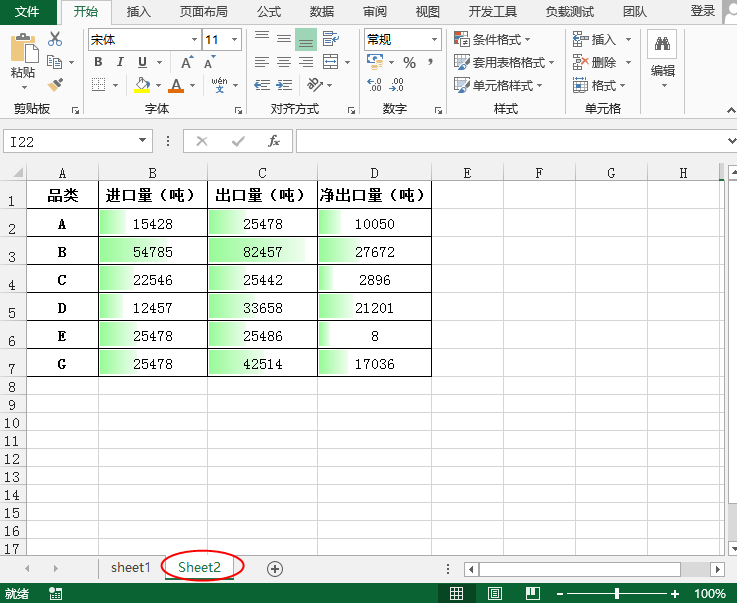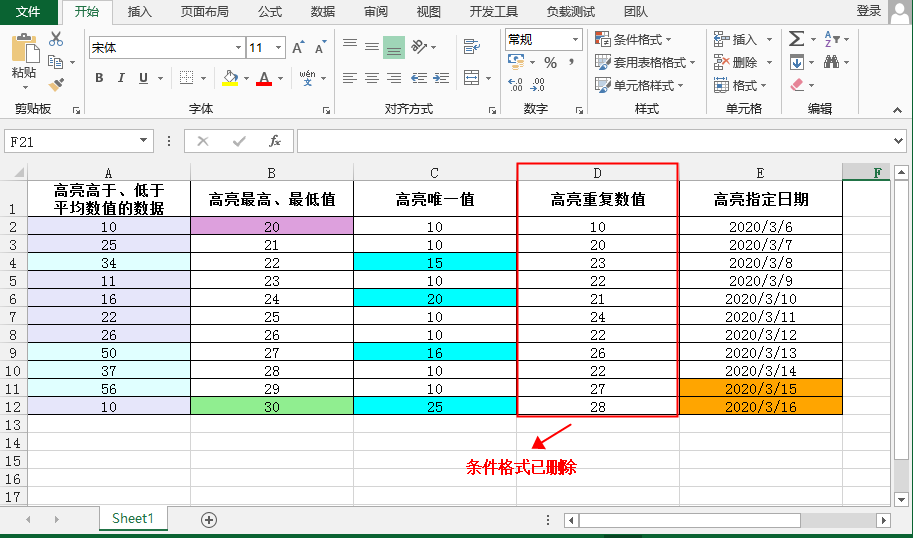Java 設置Excel條件格式示例代碼(高亮條件值、應用單元格值/公式/數(shù)據(jù)條等類型)
在Excel中,應用條件格式功能可以在很大程度上改進表格的設計和可讀性,用戶可以指定單個或者多個單元格區(qū)域應用一種或者多種條件格式。本篇文章,將通過Java程序示例介紹條件格式的設置方法,設置條件格式時,因不同設置需要,本文分別從以下示例要點來介紹:
示例1:
1. 應用條件格式用于高亮重復、唯一數(shù)值
2. 應用條件格式用于高亮峰值(最高值、最低值)
3. 應用條件格式用于高亮低于或高于平均值的數(shù)值
示例2:
1. 應用單元格值類型的條件格式
2. 應用公式類型的條件格式
3. 應用數(shù)據(jù)條類型的條件格式
示例3:
1. 刪除條件格式
程序環(huán)境 Jdk 1.8.0(高于或等于1.6.0版本即可) Free Spire.XLS for Java (免費版)Jar獲取及導入:官網(wǎng)下載jar包,并解壓將lib文件夾下的jar導入Java程序(或者通過maven下載導入到maven項目程序)。如下導入效果:

Java示例1——應用條件格式高亮重復值、唯一值、峰值、高于或低于平均值
import com.spire.xls.*;import com.spire.xls.core.IConditionalFormat;import com.spire.xls.core.spreadsheet.collections.XlsConditionalFormats;import com.spire.xls.core.spreadsheet.conditionalformatting.TimePeriodType;import java.awt.*;public class AddConditionalFormat { public static void main(String[] args) { //創(chuàng)建實例,加載測試文檔 Workbook wb = new Workbook(); wb.loadFromFile('test.xlsx'); //獲取第一個工作表 Worksheet sheet = wb.getWorksheets().get(0); //添加條件格式1并指定數(shù)據(jù)范圍 XlsConditionalFormats format1 = sheet.getConditionalFormats().add(); format1.addRange(sheet.getCellRange('A2:A12')); //高亮低于平均數(shù)值的單元格 IConditionalFormat cf1 = format1.addAverageCondition(AverageType.Below); cf1.setBackColor(new Color(230,230,250)); //高亮高于平均數(shù)值的單元格 IConditionalFormat cf2 = format1.addAverageCondition(AverageType.Above); cf2.setBackColor(new Color(224,255,255)); //添加條件格式2并指定數(shù)據(jù)范圍 XlsConditionalFormats format2 = sheet.getConditionalFormats().add(); format2.addRange(sheet.getCellRange('B2:B12')); //高亮最高值 IConditionalFormat cf3 = format2.addTopBottomCondition(TopBottomType.Top, 1); cf3.setBackColor(new Color(144,238,144)); //高亮最低值單元格 IConditionalFormat cf4 = format2.addTopBottomCondition(TopBottomType.Bottom, 1); cf4.setBackColor(new Color(221,160,221)); //添加條件格式3并指定數(shù)據(jù)范圍 XlsConditionalFormats format3 = sheet.getConditionalFormats().add(); format3.addRange(sheet.getCellRange('C2:C12')); //高亮唯一值的單元格 IConditionalFormat cf5 = format3.addDuplicateValuesCondition(); cf5.setFormatType(ConditionalFormatType.UniqueValues); cf5.setBackColor(new Color(0,255,255)); //添加條件格式4并指定數(shù)據(jù)范圍 XlsConditionalFormats format4 = sheet.getConditionalFormats().add(); format4.addRange(sheet.getCellRange('D2:D12')); //高亮重復數(shù)值的單元格 IConditionalFormat cf6 = format4.addDuplicateValuesCondition(); cf6.setFormatType(ConditionalFormatType.DuplicateValues); cf6.setBackColor(new Color(255,228,196)); //添加條件格式5并指定數(shù)據(jù)范圍 XlsConditionalFormats format5 = sheet.getConditionalFormats().add(); format5.addRange(sheet.getCellRange('E2:E12')); //高亮本周日期的單元格 IConditionalFormat cf7 = format5.addTimePeriodCondition(TimePeriodType.ThisWeek); cf7.setBackColor(new Color(255,165,0)); //保存文檔 wb.saveToFile('AddConditionalFormat.xlsx', ExcelVersion.Version2013); wb.dispose(); }}
條件格式應用效果:

Java示例2——應用單元格值、公式及數(shù)據(jù)條類型的條件格式
import com.spire.xls.*;import java.awt.*;public class AddConditionalFormat { public static void main(String[] args) { //創(chuàng)建實例,加載測試文檔 Workbook wb = new Workbook(); wb.loadFromFile('sample.xlsx'); //獲取第一個工作表 Worksheet sheet = wb.getWorksheets().get(0); //獲取應用條件格式的數(shù)據(jù)范圍 CellRange range = sheet.getCellRange('A2:H27'); //添加條件格式1 ConditionalFormatWrapper format1 = range.getConditionalFormats().addCondition(); //條件格式類型1基于單元格值 format1.setFormatType(ConditionalFormatType.CellValue); //將數(shù)值在60到90之間的單元格進行字體加粗,并設置字體顏色為橙色 format1.setFirstFormula('90'); format1.setSecondFormula('100'); format1.setOperator(ComparisonOperatorType.Between); format1.setFontColor(new Color(30,144,255)); //format1.setBackColor(Color.orange); //添加條件格式2 ConditionalFormatWrapper format2 = range.getConditionalFormats().addCondition(); format2.setFormatType(ConditionalFormatType.CellValue); format2.setFirstFormula('60'); format2.setOperator(ComparisonOperatorType.Less); format2.setFontColor(Color.red); //format2.setBackColor(Color.red); format2.isBold(); //添加邊框格式(邊框顏色、邊框類型)到條件格式2 format2.setLeftBorderColor(Color.red); format2.setRightBorderColor(new Color(0,0,139)); format2.setTopBorderColor(new Color(123,104,238)); format2.setBottomBorderColor(new Color(50,205,50)); format2.setLeftBorderStyle(LineStyleType.Medium); format2.setRightBorderStyle(LineStyleType.Thick); format2.setTopBorderStyle(LineStyleType.Double); format2.setBottomBorderStyle(LineStyleType.Double); //條件格式3的類型為公式 ConditionalFormatWrapper format3 = range.getConditionalFormats().addCondition(); format3.setFormatType(ConditionalFormatType.Formula); //自定義公式將低于60的單元格所在的行填充背景色 format3.setFirstFormula('=OR($C2<60,$D2<60,$E2<60,$F2<60,$G2<60,$H2<60)'); format3.setBackColor(Color.lightGray); //獲取第二個工作表 Worksheet sheet2 = wb.getWorksheets().get(1); //獲取應用條件格式的數(shù)據(jù)范圍 CellRange range2 = sheet2.getCellRange('B2:D7'); //添加條件類型4為data bars ConditionalFormatWrapper format4 = range2.getConditionalFormats().addCondition(); format4.setFormatType(ConditionalFormatType.DataBar); format4.getDataBar().setBarColor(new Color(152,251,152)); //保存文檔 wb.saveToFile('AddConditionalFormat2.xlsx', ExcelVersion.Version2013); wb.dispose(); }}
條件格式應用效果:


Java示例3——刪除條件格式
(這里測試文檔以示例1中生成的文檔為例)
import com.spire.xls.*;public class RemoveConditionalFormat { public static void main(String[] args) { Workbook wb = new Workbook(); wb.loadFromFile('AddConditionalFormat.xlsx'); //獲取第一個工作表 Worksheet sheet = wb.getWorksheets().get(0); //刪除指定單元格范圍中的條件格式 sheet.getCellRange('A5:H5').getConditionalFormats().removeAt(3); //保存并打開文檔 wb.saveToFile('RemoveConditionalFormat.xlsx', ExcelVersion.Version2010); wb.dispose(); }}
條件格式刪除效果:

到此這篇關(guān)于Java 設置Excel條件格式示例代碼(高亮條件值、應用單元格值/公式/數(shù)據(jù)條等類型)的文章就介紹到這了,更多相關(guān)java excel條件格式內(nèi)容請搜索好吧啦網(wǎng)以前的文章或繼續(xù)瀏覽下面的相關(guān)文章希望大家以后多多支持好吧啦網(wǎng)!
相關(guān)文章:

 網(wǎng)公網(wǎng)安備
網(wǎng)公網(wǎng)安備